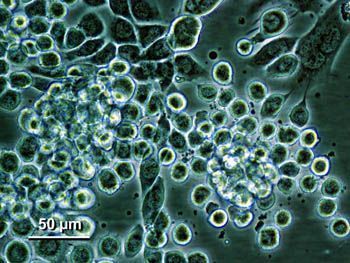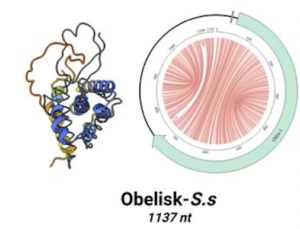Protein Science’s recombinant method involves inserting a gene for viral hemagglutinin  (HA)—a key binding protein by which flu virus attaches to respiratory cells—into the genome of cell cultures derived from the Spodoptera frugiperda caterpillar (Fall Armyworm moth).
(HA)—a key binding protein by which flu virus attaches to respiratory cells—into the genome of cell cultures derived from the Spodoptera frugiperda caterpillar (Fall Armyworm moth).
The gene transfer is done with an insect baculovirus, and once seeded, the rapidly-dividing caterpillar cells generate large volumes of pure HA. Compared with standard egg-based methods, the process requires far less resource input, and produces far more of the desired antigenic protein.
The Do-Over Advantage
It’s not only a cleaner method, it is much faster, says Dr. Cox.
Using the old-school egg medium, shot production must begin six months ahead of flu season. In the event of a strain mismatch—as happened in 2014 when the most prevalent strain proved different from the ones WHO expected— revision on the fly is impossible. You simply cannot generate half a billion eggs overnight.
The result? A large stock of largely ineffective vaccines.
Dr. Cox estimated that last year’s flu shots were at best 35% effective against the most widely prevalent H3N2 strain, and that’s being generous. The 2014-15 season went on record with more flu-related hospitalizations (an estimated 65.5 per 100,000 people) and more complications than any previous year.
Because it is essentially a “plug & play” technology, the recombinant approach allows for a rapid response to mismatches. So long as the DNA sequence for the targeted viral protein is known, scientists can reprogram the caterpillar cells to produce the required antigen within a two-month turnaround time.
Immunologically, Flublok has a similar mechanism as other flu shots: it supplies standardized amounts of viral HA, based on the premise that pre-exposure will prime an individual’s immune system to target HA on actual wild-type flu viruses.
Highly Targeted
A rapid antibody-mediated assault should, in essence, arrest the virus’ ability to adhere to and enter respiratory tissue thereby averting replication and transmission, explained immunologist John Treanor, Chief of Infections Diseases at the University of Rochester School of Medicine.
Dr. Treanor has studied recombinant HA vaccines almost since their inception, and he’s helped design trials for Protein Sciences and other companies. He says infectious disease leaders have long recognized the limitations of egg-based production, but it has been challenging to bring a viable alternative to market.
In the mid-1990s, the National Institutes of Health’s Vaccine Treatment & Evaluation Unit tried to nurture egg-free production by funding early stage trials, including ones that ultimately led to Flublok. Dr. Treanor’s center was one of those study sites.
In an interview, he said one unique feature of the new vaccine is it’s high degree of specificity. Flublok contains HA, and HA alone. Egg-grown vaccines often contain other viral surface proteins such as neuraminidase, which may (or may not) generate antibody response. Dr. Treanor says it is unclear whether these other responses are helpful. Flublok studies suggest they are unnecessary. “All you really need is antibody to hemagglutinin.”
Solid Seroconversion Rates
Dr. Treanor’s group studied over 4,600 adults randomized to receive trivalent Flublok or saline injections. The active shot contained 45 ug of recombinant HA from two influenza A strains (H1N1 and H3N2), and one B strain.
The researchers took serum from all subjects at Day 28, and nasal and throat swabs from anyone experiencing flu-like symptoms during the 2007-2008 season.
Of those who got the shots, 78% showed HA antibody responses to the H1 component, 81% had responses to the H3 component, and 52% had antibodies to the B component of the vaccine (Treanor JJ, et al. Vaccine. 2011 Oct 13;29(44):7733-9).
Compared with the saline placebo, Flublok was 44.6% effective in preventing culture-confirmed influenza, and this was despite significant antigenic mismatch between vaccine antigens and wild-type viruses that year. Rates of local and systemic side effects were low in both groups.
Kaiser Permanente researchers pitted trivalent Flublok head-to-head against a trivalent egg-based vaccine. Both contained HA antigens from two influenza A and one influenza B strains. However, the antigen content in Flublok was substantially higher than that of the conventional shot (45 mg per strain vs 15 mg per strain).
They vaccinated 601 healthy adults between the ages of 50 and 64 years. The primary endpoint was seroconversion, defined as either a shift from a pre-vaccine HA antibody titer of 10 or less to a post-vaccine titer of 40 or more, or a 4-fold increase in cases where subjects already had baseline titers over 10.
The recombinant vaccine gave higher seroconversion rates for both strains of influenza A (72% vs 66% for H1; 61% vs 44% for H3) and was equivalent to the egg-based shot for the B strain (41% seroconversion). Actual incidence of influenza-like illness was negligible in both groups (Baxter R, et al. Vaccine. 2011 Mar 9;29(12):2272-8.)
Dr. Cox shared data from a not-yet-published post-marketing efficacy study involving more than 8,500 adults over age 50. Compared with an egg-based vaccine, a quadrivalent version of Flublok reduced flu incidence by roughly 30%. She added that there’s a study underway looking at quadrivalent Flublok for kids between the ages of 6 and 17 years.
“It’s Just Flu, Right?”
Flu shots have not exactly been a hit with the public. At best, only 40% of all adults take the shot. In many places the numbers are far lower. People simply do not perceive the benefit, and are unwilling to deal with whatever the risk may be.
“It’s just the flu, right? What’s the big deal?” That’s a common attitude.







